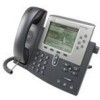Cisco 7962G Administration Guide - Page 99
Configuring Features, Templates, Services, and Users
 |
UPC - 882658140341
View all Cisco 7962G manuals
Add to My Manuals
Save this manual to your list of manuals |
Page 99 highlights
5 C H A P T E R Configuring Features, Templates, Services, and Users After you install Cisco Unified IP Phones in your network, configure their network settings, and add them to Cisco Unified Communications Manager, you must use the Cisco Unified Communications Manager Administration application to configure telephony features, optionally modify phone templates, set up services, and assign users. This chapter provides an overview of these configuration and setup procedures. Cisco Unified Communications Manager documentation provides detailed instructions for these procedures. For suggestions about how to provide users with information about features, and what information to provide, see Appendix A, "Providing Information to Users Via a Website." For information about setting up phones in non-English environments, see Appendix C, "Supporting International Users." This chapter includes following topics: • Telephony Features Available for the Cisco Unified IP Phone, page 5-1 • Configuring Corporate and Personal Directories, page 5-12 • Modifying Phone Button Templates, page 5-13 • Configuring Softkey Templates, page 5-14 • Setting Up Services, page 5-14 • Adding Users to Cisco Unified Communications Manager, page 5-15 • Managing the User Options Web Pages, page 5-15 Telephony Features Available for the Cisco Unified IP Phone After you add Cisco Unified IP Phones to Cisco Unified Communications Manager, you can add functionality to the phones. Table 5-1 includes a list of supported telephony features, many of which you can configure using Cisco Unified Communications Manager Administration. The Reference column lists Cisco Unified Communications Manager and other documentation that contains configuration procedures and related information. For information about using most of these features on the phone, refer to Cisco Unified IP Phone 7962G and 7942G Phone Guide. For a comprehensive listing of features on the phone, refer to Cisco Unified IP Phone Features A-Z. OL-14625-01 Cisco Unified IP Phone 7962G and 7942G Administration Guide for Cisco Unified Communications Manager 6.1 5-1















